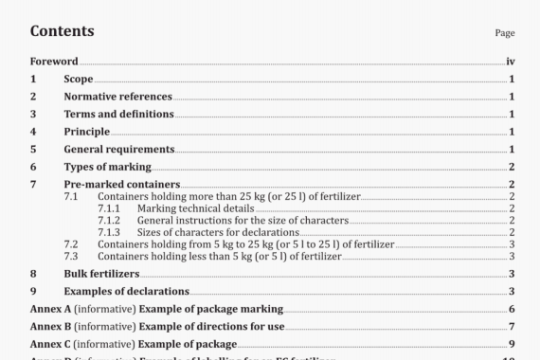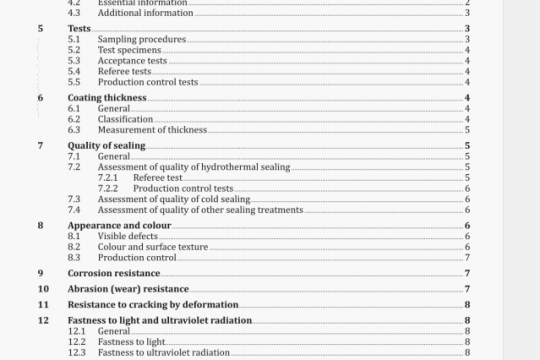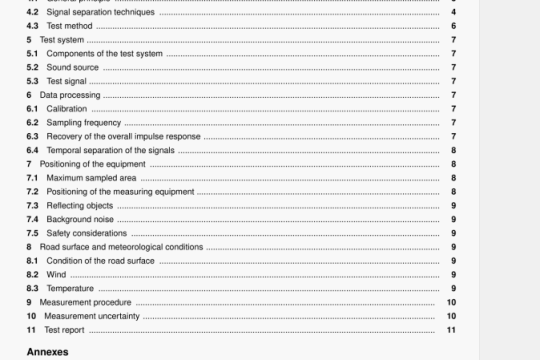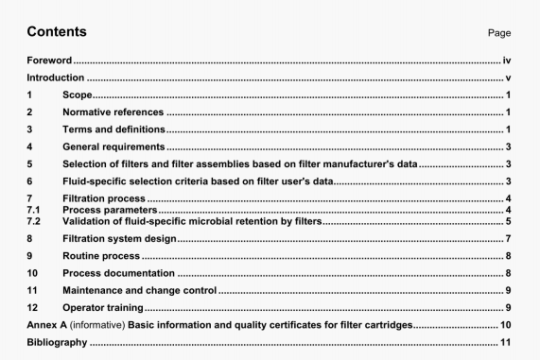ISO 14139:2000 pdf download
ISO 14139:2000 pdf download.Hydrometric determinations- Flow measurements in open channels using structures-Compound gauging structures.
The flow conditions considered are limited to steady or slowly changing flows. The essentially parallel flow through the compound structure is ensured by the use of divide piers. The flow is separated by the divide piers into each individual weir or flume. The discharge can be determined through each individual section by a single upstream head measurement, at one section only, in the case of modular flow or by two independent head measurements, at one section only, as required for drowned flow conditions. The summation of the discharges through each of the sections provides the measurement of total flow within the channel.
5 Installation
5.1 Selection of site
A preliminary survey shall be made of the physical and hydraulic features of the proposed site to check that it conforms (or may be made to conform) to the requirements necessary for measurement using the weir.
Particular attention shall be paid to the following features in selecting the site of the weir:
a) the availability of an adequate length of channel of regular cross-section;
b) the existing velocity distribution;
c) the avoidance of channels having gradients greater than 0,4 %;
d) the effects of any increased upstream water level due to the flow-measuring structure;
e) the conditions downstream, including such influences as tides, confluence with other streams, sluice-gates, mill dams and other controlling features that might cause drowning;
f) the impermeability of the ground on which the structure is to be founded, and the necessity for piling, grouting or other sealing in river installations;
g) the necessity for flood banks to confine the maximum discharge to the channel;
h) the stability of the banks, and the necessity for trimming and/or revetment in natural channels;
i) the clearance of rocks or boulders from the bed of the approach channel;
j) the effects of wind.
NOTE 1 Wind can have a considerable effect on the flow in a river or over a weir, especially if these latter are wide and the head is small and the prevailing wind is in a transverse direction.
If the site does not possess the characteristics required for satisfactory measurements, it shall be rejected unless suitable improvements are practicable.
If a survey of a stream shows that the existing velocity distribution is regular, then it should be assumed that the velocity distribution will remain satisfactory after the weir has been built.
If the existing velocity distribution is irregular and no other site for a gauge is feasible, due consideration shall be given to checking the distribution after the weir has been installed and to improving it, if necessary.
NOTE 2 Several methods are available for obtaining more precise indications of irregular velocity distribution: velocity rods, floats or concentrations of dye can be used in small channels, the latter being useful in checking conditions at the bottom of the channel. A complete and quantitative assessment of velocity distribution may be made by means of a current meter.
NOTE 3 After installation, the velocity profiles will always be improved by the increased depth of water approaching the compound weir.
5.2.1 General
The complete measuring installation consists of an approach channel, a flow-measuring structure and a downstream channel. The parameters of each of these three components affect the overall accuracy of the measurements.
Installation requirements include such features as weir finish, the cross-sectional shape of the channel, channel roughness and the influence of control devices upstream or downstream of the gauging structure.
The distribution and direction of velocity have an important influence on the performance of a weir, these factors being determined by the features mentioned in this subclause.
5.2.2 Approach channel
For all installations, the flow in the approach channel shall be smooth, free from disturbance and shall have a velocity distribution as normal as possible over the cross-sectional area (see annex A); this can usually be verified by inspection or measurement. In the case of natural streams or rivers, this flow can only be attained by having a long, straight approach channel free from projections into the flow. Unless otherwise specified in the appropriate clauses of this International Standard, the approach channel shall comply with the general requirements outlined in this subclause.
The altered flow conditions due to the construction of the weir may have the effect of building up shoals of debris upstream of the structure, which in time may affect the flow conditions. The likely consequential changes in the water level should be taken into account in the design of gauging stations.
In an artificial channel, the cross-section shall be uniform and the channel shall be straight for a length equal to at least five times its width, and more if attainable.
In a natural stream or river, the cross-section shall be reasonably uniform and the channel shall be straight for such a length as to ensure regular velocity distribution.
If the entry to the approach channel is through a bend or it the flow is discharged into the channel through a conduit of smaller cross-section or at an angle, then a longer length of straight approach channel is required to achieve a regular velocity distribution.
Baffles shall not be installed closer to the points of measurement than five times the maximum head to be measured.




